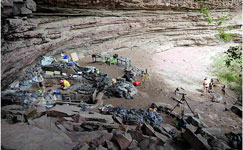Threat to South African archeological treasure
30 July 2015
By
Lyn Wadley,
University of the Witwatersrand
Sibudu, a rock shelter above the uThongathi River in KwaZulu-Natal, is one of South
Africa's most important archaeological sites. Its recent nomination for World
Heritage status demonstrates that it is of universal value, with heritage that belongs
to all humanity.
A housing development has been
approved next to the rock shelter, threatening the fragile
archaeological site.
The fate of the cave has drawn
global attention with international
scientists and scientific associations offering to help
support its survival. For South
Africans, the site creates tensions between a desire to save a precious heritage site
and the sensitive issue of providing homes for the poor.
Why Sibudu deserves to be preserved
The ancestors of all humanity evolved culturally at sites like
Sibudu. Early modern humans developed complex thought
patterns and symbolic
behavior in southern Africa. Among its prolific finds, Sibudu
has some of the earliest examples in the world of sea-shell beads, a wide variety of
bone tools, bone arrowheads for hunting, use of herbal medicine, and preserved
plant bedding – all about 70 000 years old.
Archaeobotanists have identified seeds and charred wood from trees not found in
the area today, and some plants that are valued for their medicinal
properties. This
establishes the antiquity of South Africa's profound indigenous knowledge. Hunters
brought the remains of many animals including extinct giant horse and buffalo to
the shelter. It is therefore an environmental as well as a cultural
archive.
Recently, chemical and protein analyses identified a mixture, probably from
powdered red ochre mixed with wild bovid milk. This may have been body paint or
something for decorating clothing or objects. The site is well-dated and has large
collections of stone tools.
Between 1998 and 2011, Wits University directed the
excavations, and since 2011 excavations have been
directed by a German university.
Sibudu is on the Unesco list as part of a serial nomination for World Heritage status
together with five other South African
Stone Age sites. These sites inform us about
the way early modern humans developed complex behaviour of the kind performed
by people today. The South African Heritage Resources Agency nominated Sibudu as
a National Heritage site. It was further nominated by the South African national
government for World Heritage status.
The Unesco document of July 2013, the Operational Guidelines for the
Implementation of the World Heritage Convention, defines a World Heritage site
thus:
"The cultural and natural heritage is among the priceless and irreplaceable assets,
not only of each nation, but of humanity as a whole. The loss, through deterioration
or disappearance, of any of these most prized assets constitutes an impoverishment
of the heritage of all the peoples of the world."
There is a considerable contradiction between South Africa's national nomination of
Sibudu as a World Heritage site and the provincial granting of development rights
nearby.
Development threatens Sibudu
A South African development company plans to build on sugar cane fields which it
owns. The KwaZulu-Natal department of economic development, tourism and
environmental affairs has
authorised the building project. A low income subsidy housing
estate with approximately 370 homes will be built on about 32 hectares within 300
metres of the
centre of Sibudu.
Archaeologists are concerned about the effects of an increased footprint at the site
because its dry, loose sediments are located on a slope and are susceptible to
damage by trampling.
Other archaeological sites have been destroyed or heavily vandalised when housing
developments were built nearby. Peers Cave in the Western Cape is an
example. People perceive it as a secret area within a public
place, where they can hold unnoticed parties or meetings. Fencing is an
unsatisfactory option. Experience elsewhere suggests that intentional exclusion of
people causes curiosity and invites vandalism.
The most sustainable way to protect archaeological sites is to have caretakers who
see them as resources. If Sibudu becomes a World Heritage site, there will be full-
time custodians. If wisely cared for, it can become an important archaeo-tourism
destination and educational centre. A site museum and theme park could be of
economic benefit to the local community.
When deciding on a course of action, South Africans must be cognisant that Sibudu
cannot be moved in order to preserve it. It also has a non-renewable heritage
resource that is only ours for as long as we cherish and protect it.
Lyn Wadley is Honorary Professor, School of Geography,
Archaeology and Environmental Studies at University of the Witwatersrand. She receives funding from
the National Research Foundation.
This article was originally published on The Conversation. Read the original article.

 The archaeological site of Sibudu, KwaZulu-Natal. View of the excavation area within the rock shelter. (Image: Wikimedia Commons, M Ecker)
The archaeological site of Sibudu, KwaZulu-Natal. View of the excavation area within the rock shelter. (Image: Wikimedia Commons, M Ecker)




